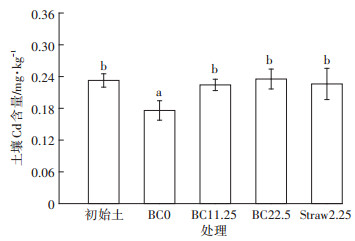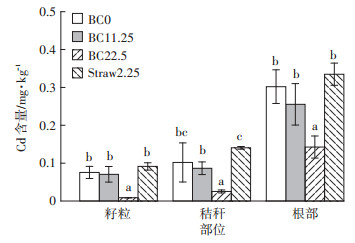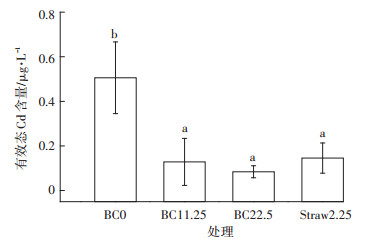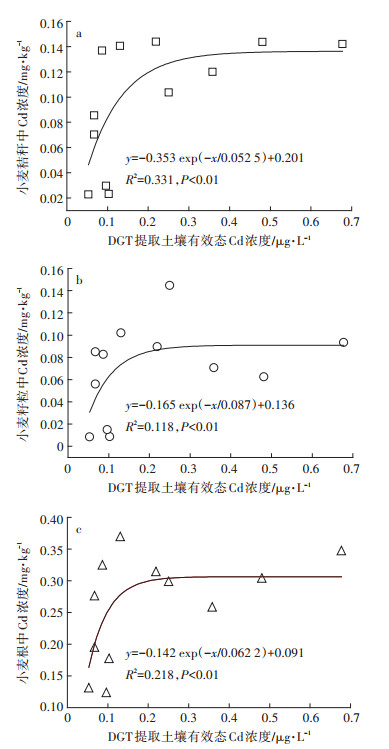秸秆资源还田是农田生态系统提高资源利用效率的主要措施,在改善土壤质量、提高土壤肥力以及作物生产力等方面应用广泛[1-2],同时也可降低土壤重金属的迁移性及有效性,从而减少作物吸收[3]。因此目前较多应用于农田土壤重金属污染修复,包括秸秆还田[4]以及秸秆炭化后再还田[5]等。然而对于清洁农田土壤,秸秆资源长期施用后是否会对未污染农田土壤产生重金属污染风险鲜见报道。
对于重金属污染风险,已有研究表明重金属的生物有效性是影响其毒性大小的关键因素[6-7]。因此许多研究者利用不同的技术手段和分析方法来预测重金属生物有效性,然而大多数方法往往都是操作定义,如何能得到反映土壤重金属的真实形态至今仍备受关注。近几年有研究表明梯度扩散薄膜技术(Dif⁃ fusive Gradients in Thin films,DGT)可通过模拟植物或其他生物对土壤重金属的吸收,有效反映土壤重金属的动态反应过程[8]。目前该技术已应用于沉积物和土壤中重金属的生物有效性研究[9-10]。如Dai等[11]的研究结果表明,相较于传统方法,DGT技术可排除土壤理化性质(如土壤pH、有机碳含量等)干扰,更好地评价土壤Cd的生物有效性。
因此,本文以中国科学院常熟农业生态试验站宜兴基地稻麦轮作农田长期秸秆及秸秆生物质炭还田试验作为研究对象,分析秸秆炭化物施用7年后对土壤Cd污染风险和小麦Cd吸收的影响,以期为清洁土壤秸秆资源长期还田是否会产生风险提供参考。
1 材料与方法 1.1 试验小区设计试验地位于中国科学院常熟农业生态实验站宜兴基地(31°07′~31°37′ N,119°31′~120°03′ E),太湖西北岸约1 km,传统稻-麦轮作模式。试验始于2010年稻季,共设4个处理:分别为不添加秸秆源的BC0处理,BC11.25处理(生物质炭施入量11.25 t·hm-2),BC22.5处理(生物质炭施入量22.5 t · hm-2)和Straw2.25处理(秸秆还田量2.25 t·hm-2)。每个处理设置3个重复,并按随机区组排列,每个小区面积为15 m2。秸秆全量还田按7.5 t · hm-2计算,试验中BC11.25处理和BC22.5处理分别为5倍和10倍秸秆全量制备的生物质炭后再还田。所用生物质炭和秸秆于上季作物收获后将地整平,人工均匀翻入土中。供试生物质炭为秸秆在高温炉中经连续阶段升温至500 ℃(5 ℃·min-1)烧制而成,其主要理化性质为[12]:pH 9.16,阳离子交换量18.9 cmol·kg-1,总有机碳和氮含量分别为620 g·kg-1和13.3 g·kg-1,灰分为276 g· kg-1,Mehlich Ⅲ试剂浸提的Ca、P、K、Na、Mg、Fe、Mn、Cu和Zn元素含量分别为2.63、1.06、18.43、3.94、1.41、0.01、0.55、0.001 6 g·kg-1和0.05 g·kg-1,其中秸秆和生物质炭中Cd浓度分别为0.70 mg·kg-1和0.20 mg·kg-1。所有处理均按照当地田间管理进行常规施肥,麦季施肥量为氮肥(尿素)240 kg N·hm-2;钾肥(氯化钾)60 kg K2O·hm-2;磷肥(过磷酸钙)60 kg P2O5·hm-2;氮肥按照3:4:3分别用作基肥:分蘖肥:拔节肥,磷肥和钾肥均用作基肥一次性施入。
1.2 样品采集与分析本研究供试土壤和植株为2017年麦季收获期土壤和植株样品,即试验进行到第7年的土壤和植株样品。取部分整株小麦植株带回实验室分析小麦籽粒、秸秆和根部Cd含量。小麦收获后,在小区内按照非系统布点法(S型)随机取5点采集0~20 cm耕层土壤,土壤样品风干,研磨,过0.841 mm和0.149 mm筛,测定其基本理化性质及重金属Cd含量,测定方法参照《土壤农业化学分析方法》[13]。土壤基本理化性质为:pH 6.05,有机碳含量15.4 g·kg-1,全氮含量为1.79 g·kg-1,砂粒(>0.05 mm)8.3%,粉粒(0.02~0.05 mm)81.5%,黏粒(< 0.02 mm)10.2%[12],试验前土壤Cd含量为0.23 mg·kg-1。土壤Cd全量采用HNO3:HCl:HF=9 mL:3 mL:1 mL,小麦籽粒、秸秆及根部Cd含量采用HNO3 9 mL微波消解(Ethos ONE),ICP-MS(Agilent 7700x)测定。
1.3 DGT提取态Cd含量(DGT-Cd) 1.3.1 DGT-Cd的提取与测定称取20 g土(过0.841 mm筛)于25 mL烧杯中,并加水至最大持水量的60%,平衡48 h,继续加水至土壤最大持水量的80%~100%,充分搅匀。将上述土壤转移至培养皿中,盖盖,放置24 h后取少量土壤,小心均匀涂抹在DGT装置采样口的滤膜上,然后将DGT采样口朝下轻轻按到土壤中,水平放置24 h。取出DGT装置,用去离子水洗去滤膜表面土壤,取出吸附膜,放入加有1 mL 1 mol·L-1 HNO3的2 mL离心管中,振荡8 h[14]。吸取提取液若干,ICP-MS(Agilent 7700x)测定。
1.3.2 DGT浓度计算(1)吸附膜上目标物的质量

|
(1) |
M:DGT吸附离子总量;Ce:洗脱液中目标物浓度;Vacid:所用提取液体积;Vgel:单片吸附膜的体积,Chelex吸附膜=0.15 mL;fe:目标物的提取效率(0.8)。
(2)溶液中被DGT测定浓度(CDGT)

|
(2) |
Δg:扩散层厚度;D:目标物在扩散层中的扩散系数,6.09 cm2·s-1(Cd,25 ℃);t:放置时间,s;A:DGT装置的采样口面积,2.54 cm2。
1.4 数据处理采用Origin 8.5进行数据绘图,SPSS 16.0软件对不同试验数据进行统计分析。采用ANOVA进行方差分析,LSD和Duncan分析法检验处理间显著性差异;采用单指数方程拟合土壤DGT-Cd含量和小麦吸收Cd含量之间的相关性(P < 0.05)。
2 结果与分析 2.1 土壤总Cd含量该试验初始土壤中Cd含量为0.23 mg·kg-1,稻麦轮作农田秸秆源生物质炭还田实施7年后,BC0、Straw2.25、BC11.25、BC22.5各处理土壤总Cd含量分别为0.18、0.23、0.22 mg·kg-1和0.24 mg·kg-1(图 1)。相较于试验初始土壤中Cd含量,Straw2.25、BC11.25和BC22.5各处理土壤中Cd含量并无显著差异,而BC0处理土壤中Cd含量显著降低(P < 0.05)。与BC0处理相比,Straw2.25、BC11.25、BC22.5各处理土壤总Cd含量分别显著高出28.5%、27.5%和33.8%(P < 0.05)。试验至目前为止,土壤总Cd含量为0.18~0.24 mg·kg-1,低于国家土壤环境质量二级标准[15](pH < 7.5的农田土壤Cd浓度限量为0.3 mg·kg-1)。

|
误差线表示同一处理3个平行样品间的标准偏差;不同字母表示不同处理间差异显著;图中数据表示为“平均值±标准差”。下同 The error bars indicate the standard deviations between three parallel samples of the same treatment; different letters indicate the significant difference among different treatments; values are given as mean±SD in figure. The same below 图 1 秸秆炭化物还田7年后麦季土壤总Cd含量变化 Figure 1 The concentration of cadmium in soil after the application of carbonization straw in the seventh year |
图 2所示为不同处理下小麦籽粒、秸秆和根部Cd含量。BC0处理下小麦籽粒、秸秆和根部Cd含量分别为0.076、0.100 mg·kg-1和0.300 mg·kg-1。BC11.25处理小麦籽粒、秸秆和根部Cd含量分别为0.070、0.086 mg· kg-1和0.260 mg·kg-1;BC22.5处理小麦籽粒、秸秆和根部Cd含量分别为0.009、0.025 mg·kg-1和0.140 mg· kg-1;Straw2.25处理小麦籽粒、秸秆和根部Cd含量分别为0.091、0.140 mg·kg-1和0.340 mg·kg-1。通过以上数据可知,不同处理下小麦对Cd的吸收主要集中在根部(占小麦体内Cd吸收量的59.5%~80.4%);且相较于BC0处理,BC22.5处理显著降低小麦籽粒、秸秆和根部Cd含量88.7%、75.3%和52.8%(P < 0.05),而BC11.25处理和Straw2.25处理均未出现显著性差异。试验至目前为止,宜兴试验区小麦籽粒中Cd含量为0.009~ 0.091 mg·kg-1,低于国家食品安全标准[16](小麦籽粒中Cd浓度限量为0.1 mg·kg-1)。

|
图 2 秸秆炭化物还田7年后小麦各器官Cd含量变化 Figure 2 The concentration of cadmium in wheat after the application of carbonization straw in the seventh year |
图 3为Straw2.25及施加生物质炭处理下麦季土壤pH变化情况。相对于BC0处理(pH 5.50),BC11.25、BC22.5和Straw2.25各处理均显著提高土壤pH(P < 0.05);其pH分别为6.26、6.70和6.18。

|
图 3 秸秆炭化物还田7年后麦季土壤pH变化 Figure 3 The variation of soil pH after the application of carbonization straw in the seventh year |
图 4为Straw2.25处理和施加生物质炭处理DGT提取态Cd含量变化。BC0、BC11.25、BC22.5和Straw2.25处理DGT-Cd浓度分别为0.51、0.13、0.08 μg·L-1和0.15 μg·L-1。相对于BC0处理,BC11.25、BC22.5和Straw2.25处理下DGT-Cd含量分别显著降低74.6%、83.4%和71.2%(P < 0.05)。

|
图 4 秸秆炭化物还田7年后麦季土壤DGT提取态Cd含量 Figure 4 The concentration of DGT-Cd in soil after the application of carbonization straw in the seventh year |
采用指数方程拟合DGT提取态Cd含量与小麦籽粒、秸秆和根部中Cd含量的相关性如图 5a、图 5b、图 5c所示,拟合结果为指数方程关系,均呈显著相关性(P < 0.01);秸秆、籽粒、根的R2值分别为0.331、0.118和0.218。

|
图中数据表示为“平均值±标准差” Values are given as mean±SD in figure 图 5 DGT提取态Cd与小麦籽粒、秸秆和根部Cd含量的相关性 Figure 5 Correlation between DGT-Cd and the concentration of Cd in grains/straws/roots of wheat |
宜兴稻麦轮作农田秸秆及生物质炭还田实施7年后,土壤总Cd含量显著增加。这可能由于秸秆自身或者生物质炭在高温裂解碳化制备过程中,Cd等重金属在生物质炭中的浓缩并通过还田进入土壤导致[17]。Shen等[18]研究表明土壤中Cd含量升高与添加生物质炭中的重金属含量密切相关。Wang等[19]也曾报道添加含Cd秸秆显著增加土壤Cd含量。此外,本文发现秸秆与BC11.25处理下小麦Cd吸收量无显著性差异,而BC22.5处理下小麦Cd吸收量显著降低,这主要是因为生物质炭可通过调节土壤pH来降低土壤重金属的有效性:相对于空白对照处理pH 5.50,BC22.5处理下土壤pH显著增加至6.70。Shi等[20]的研究结果表明,土壤pH增加可显著降低土壤中Cd的生物有效性,从而降低Cd在水稻中的富集。Bradl[21]和Zheng等[22]的研究结果亦表明,添加生物质炭可提高土壤pH,其表面携带大量负电荷,有利于吸附土壤中重金属等金属阳离子。不仅如此,生物质炭较大的比表面积也有利于降低重金属的迁移性与有效性[23]。本文试验结果表明秸秆还田处理下土壤pH显著升高,可能是添加秸秆后土壤交换性酸显著降低导致的[24-25];也可能是秸秆中有机阴离子的去羧基过程(R-CO-COO- + H+→ RCHO+CO2)或在秸秆腐解过程中有机氮转化成NH4+(有机氮→ NH4++OH-)造成的[26]。但也有研究表明秸秆还田主要通过影响土壤有机质含量和形态来影响土壤重金属的迁移性、溶解性及其生物有效性,进而影响土壤中重金属含量变化及其在作物中的迁移累积[27-28]。Tang等[29]最近通过添加水稻秸秆对Cd的植物有效性影响机理的研究结果表明,添加秸秆主要通过影响土壤和孔隙水中有机质与Cd的相互作用方式,如固定作用或络合作用,来降低土壤中生物有效态Cd含量。
土壤中重金属的生物毒性很大程度上取决于其生物有效态含量而非总量[30]。以往评价土壤中重金属生物毒性常采用化学提取方法,例如乔显亮[31]和章明奎[32]等就污染土壤中重金属的生物有效性进行了较为系统的方法比较,表明DGT技术可作为研究土壤重金属生物有效性的有效且可靠的方法。相较于传统方法,DGT技术优势明显,如可模拟土壤动态反应过程、原位定量化测定土壤中有效态重金属浓度以及降低因土壤理化性质变化对重金属提取效率的干扰等,可较为准确地表征土壤重金属的生物有效性[33-34]。本文采用DGT技术测定土壤有效态Cd含量,结果表明秸秆或秸秆炭化后还田均可显著降低土壤Cd生物有效性。类似结果亦有所报道,如Moreno-Jiménez等[35]采用DGT技术进行有效态重金属含量测定,结果表明添加生物质炭可显著降低大麦籽粒中Cd和Pb的浓度。Lomaglio等[36]的研究结果表明生物质炭可显著提高土壤pH、降低土壤中活性Pb的浓度。然而,本文进一步通过指数方程拟合发现土壤DGT-Cd含量与小麦籽粒、秸秆和根部Cd含量均具有显著相关性,但相关性不高。Yao等[37]和宋宁宁等[38]的研究结果表明DGT提取的土壤有效态Cd含量与植物组织中的Cd含量呈显著相关关系。推测本试验DGT-Cd含量与小麦组织中Cd含量相关性不高的原因可能是由于土壤Cd含量较低,采用秸秆炭化还田后由于土壤pH的增加以及吸附作用导致土壤DGT-Cd含量下降显著;此外,也有文献表明,小麦对于营养元素(例如磷)的吸收也会影响Cd在小麦体内的转移及吸收量[39-40]。因此,本试验采用DGT技术表征土壤有效态Cd含量,可为秸秆源生物质炭长期还田的重金属风险评价提供一种技术参考。
4 结论通过对宜兴稻麦轮作农田实施秸秆或秸秆生物质炭连续还田试验7年后土壤和小麦中重金属Cd的含量分析,发现长期秸秆或秸秆生物质炭还田下土壤总Cd含量增加,但均显著降低DGT提取态Cd含量,同时高倍生物质炭处理显著降低小麦各部位对Cd的吸收量。DGT提取态Cd与小麦Cd吸收量具有显著相关性。因此本试验中长期秸秆资源还田短期内土壤总Cd含量存在潜在的生态风险较小,同时可显著降低土壤有效态Cd含量及小麦各组织中Cd含量。
| [1] |
Cavalieri K M V, da Silva A P, Tormena C A, et al. Long-term effects of no-tillage on dynamic soil physical properties in a Rhodic Ferrasol in Paraná, Brazil[J]. Soil and Tillage Research, 2009, 103(1): 158-164. DOI:10.1016/j.still.2008.10.014 |
| [2] |
戴中民.生物炭对酸化土壤的改良效应与生物化学机理研究[D].杭州: 浙江大学, 2016. DAI Zhong-min. The effect of biochar on acid soil improvement and related biochemical mechanisms[D]. Hangzhou: Zhejiang University, 2016. |
| [3] |
Zhao S, Li K, Zhou W, et al. Changes in soil microbial community, enzyme activities and organic matter fractions under long-term straw return in north-central China[J]. Agriculture, Ecosystems & Environment, 2016, 216: 82-88. |
| [4] |
He J, Lin L, Ma Q, et al. Effects of mulching accumulator straw on growth and cadmium accumulation of Cyphomandra betacea seedlings[J]. Environmental Progress & Sustainable Energy, 2016, 36(2): 366-371. |
| [5] |
张晶, 苏德纯. 秸秆炭化后还田对不同镉污染农田土壤中镉生物有效性和赋存形态的影响[J]. 农业环境科学学报, 2012(10): 1927-1932. ZHANG Jing, SU De-chun. Phytoavailability and chemical speciation of Cd in different Cd-contaminated soils influenced by bio-char incorporation[J]. Journal of Agro-Environment Science, 2012(10): 1927-1932. |
| [6] |
Sonmez O, Pierzynski G M. Assessment of zinc phytoavailability by diffusive gradients in thin films[J]. Environmental Toxicology & Chemistry, 2005, 24(4): 934. |
| [7] |
Tusseau-Vuillemin M H, Gilbin R, Bakkaus E, et al. Performance of diffusion gradient in thin films to evaluate the toxic fraction of copper to Daphnia magna[J]. Environmental Toxicology & Chemistry, 2004, 23(9): 2154-2161. |
| [8] |
Davison W, Zhang H. In-situ speciation measurements of trace components in nature-water using thin-file gels[J]. Nature, 1994, 367(6463): 546-548. DOI:10.1038/367546a0 |
| [9] |
Yao Y, Sun Q, Wang C, et al. Evaluation of organic amendment on the effect of cadmium bioavailability in contaminated soils using the DGT technique and traditional methods[J]. Environmental Science and Pollution Research, 2017, 24(9): 7959-7968. DOI:10.1007/s11356-015-5218-8 |
| [10] |
Wegener J W M, van den Berg G A, Stroomberg G J, et al. The role of sediment-feeding oligochaete Tubifex on the availability of trace metals in sediment pore waters as determined by diffusive gradients in thin films(DGT)[J]. Journal of Soils and Sediments, 2002, 2(2): 71-76. DOI:10.1007/BF02987874 |
| [11] |
Dai Y, Nasir M, Zhang Y, et al. Comparison of DGT with traditional extraction methods for assessing arsenic bioavailability to Brassica chinensis in different soils[J]. Chemosphere, 2018, 191: 183-189. DOI:10.1016/j.chemosphere.2017.10.035 |
| [12] |
何莉莉.秸秆生物炭对农田土壤硝化和反硝化作用的影响[D].北京: 中国科学院大学, 2017. HE Li-li. The effects of rice-straw biochar addition on nitrification and denitrification in agricultural soil[J]. Beijing: University of Chinese Academy of Science, 2017. |
| [13] |
鲁如坤. 土壤农业化学分析方法[M]. 北京: 中国农业科技出版社, 2000. LU Ru-kun. Soil agrochemical analysis method[M]. Beijing: China Agricultural Science and Technology Press, 2000. |
| [14] |
Zhang H, Davison W, Tye A M, et al. Kinetics of zinc and cadmium release in freshly contaminated soils[J]. Environmental Toxicology and Chemistry, 2006, 25(3): 664-670. DOI:10.1897/04-664R.1 |
| [15] |
GB15168-2018.土壤环境质量标准[S]. GB15168-2018. Environmental quality standard for soils[S]. |
| [16] |
GB2762-2012.食品中镉限量卫生标准[S]. GB2762-2012. Cadmium limited standard for foods[S]. |
| [17] |
仓龙, 朱向东, 汪玉, 等. 生物质炭中的污染物含量及其田间施用的环境风险预测[J]. 农业工程学报, 2012, 28(15): 163-167. CANG Long, ZHU Xiang-dong, WANG Yu, et al. Pollutant contents in biochar and their potential environmental risks for field application[J]. Transactions of the Chinese Society of Agricultural Engineering, 2012, 28(15): 163-167. |
| [18] |
Shen X, Huang D Y, Ren X F, et al. Phytoavailability of Cd and Pb in crop straw biochar-amended soil is related to the heavy metal content of both biochar and soil[J]. Journal of Environmental Management, 2016, 168(1): 245-251. |
| [19] |
Wang S, Huang D Y, Zhu Q H, et al. Speciation and phytoavailability of cadmium in soil treated with cadmium-contaminated rice straw[J]. Environmental Science and Pollution Research, 2015, 22(4): 2679-2686. DOI:10.1007/s11356-014-3515-2 |
| [20] |
Shi G L, Lu H Y, Liu J Z, et al. Periphyton growth reduces cadmium but enhances arsenic accumulation in rice(Oryza sativa) seedlings from contaminated soil[J]. Plant and Soil, 2017, 421(1/2): 137-146. |
| [21] |
Bradl H B. Adsorption of heavy metal ions on soils and soils constituents[J]. Journal of Colloid & Interface Science, 2004, 277(1): 1-18. |
| [22] |
Zheng R L, Cai C, Liang J H, et al. The effects of biochars from rice residue on the formation of iron plaque and the accumulation of Cd, Zn, Pb, As in rice(Oryza sativa L.)seedlings[J]. Chemosphere, 2012, 89(7): 856-862. DOI:10.1016/j.chemosphere.2012.05.008 |
| [23] |
Kim H S, Kim K R, Kim H J, et al. Effect of biochar on heavy metal immobilization and uptake by lettuce (Lactuca sativa L.) in agricultural soil[J]. Environmental Earth Sciences, 2015, 74(2): 1249-1259. DOI:10.1007/s12665-015-4116-1 |
| [24] |
兰丽丽.添加不同作物秸秆对土壤酸度变化的影响[D].长春: 吉林农业大学, 2015. LAN Li-li. Effects of different crop straw on soil acidification changes[D]. Changchun: Jilin Agricultural University, 2015. |
| [25] |
林涵.长期不同施肥对黑土酸度变化的影响[D].长春: 吉林农业大学, 2014. LIN Han. The influence of different fertilization system on soil acidification[D]. Changchun: Jilin Agricultural University, 2014. |
| [26] |
周领.秸秆类型和土壤性质对CO2-C释放速率和土壤pH影响的研究[D].杭州: 浙江大学, 2010. ZHOU Ling. Effect of different crop residual and soil properties on CO2-C evolved rate and pH in red soil[D]. Hangzhou: Zhejiang University, 2010. |
| [27] |
Zhu H, Zhong H, Wu J. Incorporating rice residues into paddy soils affects methylmercury accumulation in rice[J]. Chemosphere, 2016, 152: 259. DOI:10.1016/j.chemosphere.2016.02.095 |
| [28] |
Zhu H, Zhong H, Evans D, et al. Effects of rice residue incorporation on the speciation, potential bioavailability and risk of mercury in a contaminated paddy soil[J]. Journal of Hazardous Materials, 2015, 293: 64. DOI:10.1016/j.jhazmat.2015.03.051 |
| [29] |
Tang W, Zhong H, Xiao L, et al. Inhibitory effects of rice residues amendment on Cd phytoavailability:A matter of Cd-organic matter interactions?[J]. Chemosphere, 2017, 186: 227-234. DOI:10.1016/j.chemosphere.2017.07.152 |
| [30] |
罗军, 王晓蓉, 张昊, 等. 梯度扩散薄膜技术(DGT)的理论及其在环境中的应用Ⅰ:工作原理、特性与在土壤中的应用[J]. 农业环境科学学报, 2011, 30(2): 205-213. LUO Jun, WANG Xiao-rong, ZHANG Hao, et al. Theory and application of diffusive gradients in thin films in soils[J]. Journal of Agro-Environment Science, 2011, 30(2): 205-213. |
| [31] |
乔显亮, 骆永明. 污泥土地利用研究Ⅱ.连续化学提取法研究施污泥土壤重金属的有效性和环境风险[J]. 土壤, 2001, 33(4): 210-213. QIAO Xian-liang, LUO Yong-ming. Study on sludge land use Ⅱ. Study on the effectiveness and environmental risk of heavy metals in sludge soil by continuous chemical extraction[J]. Soils, 2001, 33(4): 210-213. DOI:10.3321/j.issn:0253-9829.2001.04.009 |
| [32] |
章明奎, 方利平, 周翠. 污染土壤重金属的生物有效性和移动性评价:四种方法比较[J]. 应用生态学报, 2006, 17(8): 1501-1504. ZHANG Ming-kui, FANG Li-ping, ZHOU Cui. Evaluation of heavy metals bioavailability and mobility in polluted soils:A comparison of four methods[J]. Chinese Journal of Applied Ecology, 2006, 17(8): 1501-1504. DOI:10.3321/j.issn:1001-9332.2006.08.028 |
| [33] |
Lehto N J, Davison W, Zhang H, et al. Analysis of micro-nutrient behaviour in the rhizosphere using a DGT parameterised dynamic plant uptake model[J]. Plant and Soil, 2006, 282(1/2): 227-238. |
| [34] |
Simpson S L, Yverneau H, Cremazy A, et al. DGT-Induced copper flux predicts bioaccumulation and toxicity to bivalves in sediments with varying properties[J]. Environmental Science & Technology, 2012, 46(16): 9038-9046. |
| [35] |
Moreno-Jiménez E, Fernández J M, Puschenreiter M, et al. Availability and transfer to grain of As, Cd, Cu, Ni, Pb and Zn in a barley agrisystem:Impact of biochar, organic and mineral fertilizers[J]. Agriculture Ecosystems & Environment, 2016, 219: 171-178. |
| [36] |
Lomaglio T, Hattab-Hambli N, Bret A, et al. Effect of biochar amendments on the mobility and (bio) availability of As, Sb and Pb in a contaminated mine technosol[J]. Journal of Geochemical Exploration, 2016, 182: 138-148. |
| [37] |
Yao Y, Sun Q, Wang C, et al. Evaluation of organic amendment on the effect of cadmium bioavailability in contaminated soils using the DGT technique and traditional methods[J]. Environmental Science & Pollution Research, 2017, 24(9): 7959-7968. |
| [38] |
宋宁宁, 王芳丽, 赵玉杰, 等. 基于梯度薄膜扩散技术评估黑麦草吸收Cd的研究[J]. 中国环境科学, 2012, 32(10): 1826-1831. SONG Ning-ning, WANG Fang-li, ZHAO Yu-jie, et al. Assessment of cadmium bioavailability to ryegrass in soils by diffusive gradients in thin films[J]. China Environmental Science, 2012, 32(10): 1826-1831. DOI:10.3969/j.issn.1000-6923.2012.10.015 |
| [39] |
史高玲, 马鸿翔, 娄来清, 等. 小麦株高和茎秆不同部位砷镉磷含量与籽粒砷镉磷含量的关系[J]. 农业环境科学学报, 2017, 36(1): 8-15. SHI Gao-ling, MA Hong-xiang, LOU Lai-qing, et al. Relationship between arsenic, cadmium, and phosphorus concentration in different parts of wheat straw, wheat plant height and grain arsenic, cadmium, and phosphorus concentrations[J]. Journal of Agro-Environment Science, 2017, 36(1): 8-15. |
| [40] |
Shi G L, Zhu S, Bai S N, et al. The transportation and accumulation of arsenic, cadmium, and phosphorus in 12 wheat cultivars and their relationships with each other[J]. Journal of Hazardous Materials, 2015, 299: 94-102. DOI:10.1016/j.jhazmat.2015.06.009 |
 2019, Vol. 38
2019, Vol. 38


